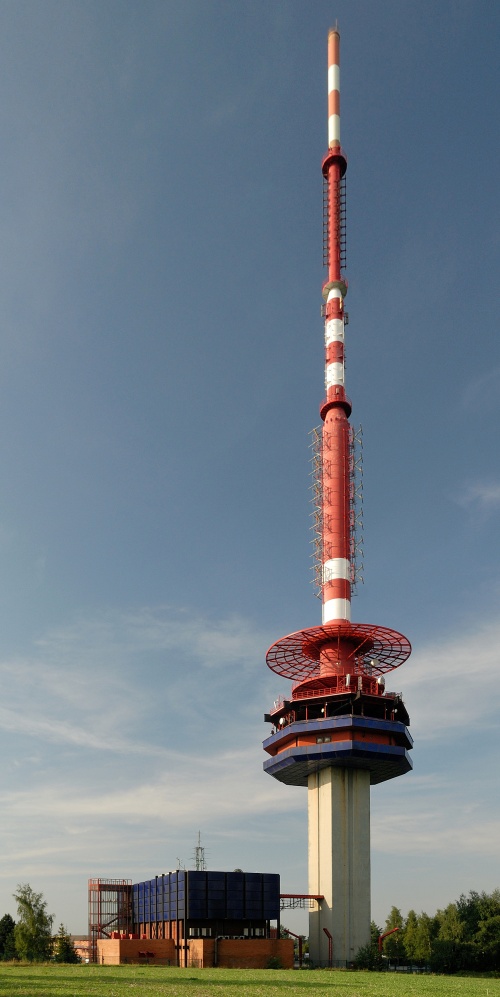
40 years ago, the television tower in Ostrava was put into operation
 |
| photo: Roman Polášek |
The first broadcasting structure was built on the site back in 1955, making it the second television transmitter in Czechoslovakia after the transmitter on Prague's Petřín. The current tower, which was constructed after five years of work, stands exactly 184 meters tall, and is thus 32 meters shorter than the transmitter in Prague's Žižkov. Like the Žižkov transmitter, the Ostrava television tower is the work of architect Václav Aulický. The base of the transmitter is situated at an altitude of 276 meters above sea level.
For 40 years, the red, blue, and white television transmitter in Ostrava-Hošťálkovice has been a dominant feature of the Hlučín Highlands, visible from many places. However, few know that the area is adorned with a statue of a two-tailed lion created by sculptor Olbram Zoubek. Nor do they know that, aside from short-term outages or planned downtimes, the signal of television and radio broadcasting has never ceased to be transmitted from the top of the 184-meter-high tower. Broadcasting continued from Hošťálkovice even during the military invasion in 1968 and during the catastrophic floods in 1997.
 |
| photo: Petr Sikula |
Mocek, a graduate of the University of Transport and Communications, has been working in Hošťálkovice since 1986. He started there before his military service and returned to the transmitter afterward. "I thought it was a very attractive job back then. You travel a lot to other transmitters. It's not just an office job," he explained.
According to him and other witnesses, the transmitter has never been non-functional during its existence. "I don't count planned downtimes, which happen once a year. Nor short-term outages caused by malfunctions, which were replaced by the signal from the backup transmitter within minutes," he said.
The propagation of the signal, even then from the original 123-meter high steel mast, was not halted by Soviet soldiers during the invasion in 1968. Tanks reached the gate of the area. The transmitter staff removed the colored bulbs that indicated that the transmitter was in operation. Therefore, any potential inspection could not immediately determine whether broadcasting was taking place or not. Mocek and his team also experienced a dramatic situation during the floods in 1997. Water flooded into the basement towards the high-voltage power supply cables. "We had to pump the water out. It was unpleasant, but even then there was no outage," he added.
The construction of the current transmitter began in 1975. Work according to Václav Aulický's design lasted until 1979. The transmitter replaced the original 123-meter high lattice structure from 1955. The 184-meter-high tower is among the 40 tallest buildings in the Czech Republic. Architect Aulický is also the author of the television transmitter in Prague's Žižkov, which is 32 meters taller than the Ostrava television tower.
Part of the ground area of the Hošťálkovice facility includes a two-meter statue of a two-tailed lion by sculptor Olbram Zoubek. "Back then, it was common for part of the budget for such constructions to be allocated for the creation of works of art. Zoubek created this silver lion for the transmitter. It is said that some comrades found the animal's expression too pessimistic. Therefore, he had to modify the work at their request. So today, the lion does indeed smile slightly," said Mocek.
The English translation is powered by AI tool. Switch to Czech to view the original text source.
0 comments
add comment











